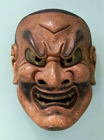April 12, 2005 (Tue) - May 22, 2005 (Sun)
This exhibition focuses on the expressions of wrath, primarily through Buddhist statues and masks. Expressions of Wrath can be divided into two large groups. One group features faces such as those of Acalanatha, an Esoteric Buddhist deity, and the Four Guardian Kings of Buddhism. The other has faces of devils and demons. The faces express abhorrence one might have for their worst enemy, concurrently the expressions have a similarity to an angry parent, disciplining a foolish child. Anger can be judged by paying attention to the eyes, mouth, teeth, horns, and the amount of muscle on the face.
Wrath, expressed in the statues, has varied through the ages. In the late Heian period (794 - 1192), brave rather than angry would be a more appropriate expression. By the Kamakura period (1192 - 1333), the statues had become overpowering figures with powerful chiseled features and bloodshot eyes.
From the Muromachi period (1392 - 1573), when Noh drama emerged as a powerful catalyst in the art world, various masks were used to display a wide variety of expressions, including anger. Among the Noh masks are those of the hannya, or demonesses. The hannya start off as elegant women, but through unfolding events, become engulfed in rage, and are transformed into demons. Their faces clearly reflect their emotions: a range of jealousy, disgrace, disappointment, and fury, but at the same time, their sorrow.

